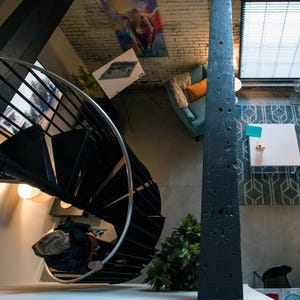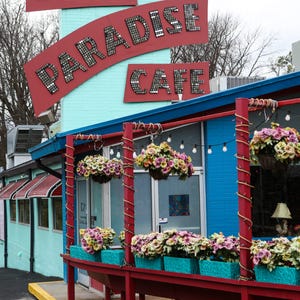Vintage Christmas lights hanging outside a two-bedroom shotgun house on Samuel Street are the first small clues hinting at a new life inside.
Since May — when owners Laurel Sims-Stewart and Justin Stewart, both 28, closed on the property — the Germantown home has experienced several changes. Its carpets have been replaced with wood flooring. Its dropped ceilings returned to their original height. And in the kitchen, bright colors have covered an underwhelming beige.
The house as it stood wasn’t unlivable, Stewart said. But it didn’t fit the young couple’s style. So in a move that’s become increasingly familiar in the neighborhood, they made it their own.
No one is quite sure when the movement started, but in the past five to 10 years, something drastic has happened in and around Germantown — causing the entire city to take notice of the working class neighborhood that’s becoming the next major hot spot at breakneck speed.
Homes that have been standing since the 1800s are quickly filling with young families, who can’t afford the Highlands yet they are spending three to four times what they might have paid for the Germantown properties just two decades ago. Local bars are changing hands, with new owners catering to the growing millennial market through craft beer and higher-priced menus. And several large-scale apartment complexes are making use of the industrial mills that built the neighborhood, turning the mostly vacant structures into living space for hundreds of new and returning residents.
Like many first-time home buyers, Sims-Stewart, who moved to Germantown from the Highlands, said she’s excited about all the coming changes. But she also wonders if the developments will interfere with the community’s character. Is it possible that modernity could overshadow tradition?
“Gentrification is a real thing, so we do have to be careful about coming in and making too many changes to a community that people really might love,” Sims-Stewart said. “… But I look forward to, if we have a family someday, knowing that there are going to be other families in our neighborhood, and it isn’t going to be a neighborhood that just dies out. …”
Small-town vibe
As of June 2015, the median sales price for a home in Germantown was $130,000, according to data provided by the Jefferson County Property Valuation Administrator’s office. In Schnitzelburg, the median was slightly higher at $136,200.
Both of those figures are up 13 to 20 percent from 2011 — when the median price was $120,425 in Schnitzelburg and $108,375 in Germantown. And they’re definitely up from the 1970s, when Hank Oechslin bought a house on Lydia Street in Schnitzelburg for just $8,000.
“I bought four of them on the 1100 block years ago, and the most I paid was $13,500,” said Oechslin, who still lives a block away in the home his dad built. “… The property values in Germantown have gone sky high. I can’t believe. I was in the game for quite a while, and I can’t believe it.”
Oechslin, 83, is a neighborhood lifer who’s flipped several homes and at one time owned the Old Hickory Inn at 1038 Lydia Street. He still remembers when industrial plants ruled the neighborhood and you could set your clock by when locals showed up to their corner bar.
“Everybody knew each other,” Oechslin said. “And if you didn’t show up two days in a row, somebody would check on you.”
Decades later, the mills are gone, but that small-town vibe is still there. Several traditions — including the annual Dainty Contest and #1 Citizen dinner — have persisted for up to 50 years. And Old Hickory Inn’s current owner, John Malone, said he can still name most of the people who live on his bar’s street.
Both Malone, 60, and Oechslin say it’s hard, though, not to notice the changes. Outside the bar, bike lanes are painted on nearby roads. Inside, Malone has installed a credit card machine for customers of another generation.
“I look at the receipts the next morning, and I don’t know a name on them,” Malone said.
Malone and Oechslin agree Germantown wasn’t in need of a major revitalization. The community has always been strong and was never plagued by a plethora of boarded up homes.
But the men and other local business owners say they also see the benefits of what District 10 Metro Councilman Pat Mulvihill calls a “regeneration.” As the community’s long-term residents have grown older, their homes have fallen behind the times. And while younger families are changing the face of the neighborhood, they’re also bringing the income needed to keep the area on track.
“You start putting people with higher incomes into these small areas, they’ve got a lot more spendable cash,” said John Murrow, owner of Check’s Cafe at 1101 E. Burnett Ave. “They don’t want to have to drive across town to buy stuff or to go to eat. So you’re seeing with a lot of big business guys, they’re wanting to get in on the action.”
The Stewarts said it’s too soon to tell how the new development will actually shape the neighborhood, but they said being involved in a caring community is one of their favorite parts of Germantown.
Since moving to Samuel Street, the couple has downloaded a social media phone app called Nextdoor that lets them communicate with others about neighborhood issues, and they’ve made friends with an elderly neighbor who recently made them soup as a thank you for bringing her food after a surgery.
“It’s just sort of taking care of people,” Sims-Stewart said. “You can get that no matter where you go, but I think you have to purposefully build that in some places, where it comes more naturally in other places…. I grew up in a neighborhood where we took care of each other too. Now that I’m building my own family in a neighborhood, that’s what I want for myself.”
‘If it’s not changing, it’s dying’
Inside the Germantown Mill Lofts apartments — which are expected to open in phases early next year — thick black marks have been left on hardwood floors and exposed brick makes up much of the walls, reminders of the building’s past as one of the state’s largest cotton mills.
It’s been a learning curve for Jeff Underhill not to remove the marks or paint over the brick, like his company, Underhill Associates, would do in other urban development projects. But after seeing the apartments progress, he understands the elements have to be there. They’re part of what gives Germantown and its properties character.
The Underhills, like other developers who have started or announced projects in Germantown and Schnitzelburg, are not directly from the area. But after speaking to several developers about their plans — from housing complexes to a cocktail bar — it seems the group is also not made up of ruthless businessmen who want to turn the neighborhoods into something they’re not.
“If you don’t have a marketplace, then your neighborhood is dying,” Underhill said. “If it’s not changing, it’s dying. But you can keep it unique, not make it corporate.”
By the nature of Germantown and Schnitzelburg — both a maze of residential roads lined with shotgun homes and camelbacks — an influx of massive commercial developments isn’t really an option. So far, developers wanting to be part of the area’s upswing have also mostly stuck to its historical footprint, making few changes to their buildings’ outsides.
The concepts being proposed inside the buildings, however, are what have confused some neighborhood residents.
“Some people say, ‘Gosh, Mike, you think upscale in Germantown?'” said Mike Morris, president of the Schnitzelburg Area Community Council. “I say, ‘Hey, man, it’s the generational change in things.’ A lot of people thought Eiderdown would never go over because it’s a pretty fancy, pricey restaurant. But it’s done great, and other things have followed, like Four Pegs.”
One reason the area’s new businesses — like The Post and Lydia House — are succeeding is the attention they’ve received from customers outside the neighborhoods. As more people citywide look at Germantown as the place to go, local business owners have joined the movement, announcing plans that will create a variety of options for both nearby residents and others across Louisville.
Within the next year, at least four new bars and restaurants are expected to open on Goss Avenue — what Morris calls Germantown’s Main Street.
In the former Groucho’s building at 935 Goss Ave., across from the Germantown Mill Lofts, property owner David Gilbert has proposed a “timeless” cocktail bar that is expected to be open before Derby.
Gilbert said he knows change can be scary, but he agrees with Underhill that well-done change is necessary.
“The minute you have more professional investors, as long as they have good taste and don’t screw it up by having a sense of not alienating the neighborhood, over time you will see it advance,” Gilbert said.
Gant Hill, the president and principal broker for Gant Hill Associates, is a partner in a new venture that’s purchased the former Pauly’s Schnitzelburg Pub, located on Goss near Texas Avenue. The group has not yet stated who will lease the building or what the bar will become, but Hill said the team plans to create a “very honest or genuine bar” for the neighborhood — fitting with the corner bars that existed for more than a century.
“Germantown, at this moment in time, is raw and uncut in some ways,” Hill said. “And it’s the way it’s been for many years. Finally, we’re at a place in our development of our community where we can find harmony in the aspects of it that make it what it was. … You see people embracing what was real and original more than anything.”
Reach reporter Bailey Loosemore at 502-582-4646 or bloosemore@courier-journal.com.
WHERE IS GERMANTOWN?
Don’t laugh; it’s a serious question. To many people — both inside and outside the neighborhood — Germantown is a massive community that takes up the area west of the Highlands and east of Old Louisville. However, that area actually consists of several neighborhoods, including Schnitzelburg and Paristown. Germantown, itself, is an odd shape that’s mostly bound by Barret Avenue, Breckinridge Street, Steve Magre Alley, Goss Avenue and Eastern Parkway. Schnitzelburg, on the other side of Goss, is bound by Shelby Street, Clarks Lane and Goss Avenue.
http://www.courier-journal.com/story/news/local/2015/12/17/germantown-popularity-soars-mix-old-new/76676232/



